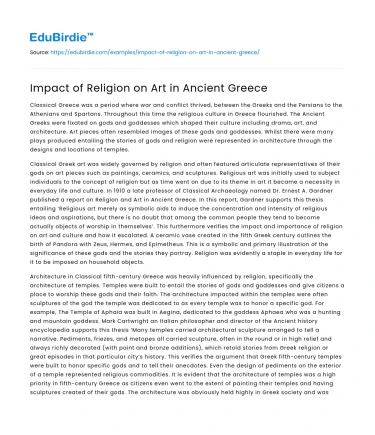Classical Greece was a period where war and conflict thrived, between the Greeks and the Persians to the Athenians and Spartans. Throughout this time the religious culture in Greece flourished. The Ancient Greeks were fixated on gods and goddesses which shaped their culture including drama, art, and architecture. Art pieces often resembled images of these gods and goddesses. Whilst there were many plays produced entailing the stories of gods and religion were represented in architecture through the designs and locations of temples.
Classical Greek art was widely governed by religion and often featured articulate representatives of their gods on art pieces such as paintings, ceramics, and sculptures. Religious art was initially used to subject individuals to the concept of religion but as time went on due to its theme in art it became a necessity in everyday life and culture. In 1910 a late professor of Classical Archaeology named Dr. Ernest A. Gardner published a report on Religion and Art in Ancient Greece. In this report, Gardner supports this thesis entailing ‘Religious art merely as symbolic aids to induce the concentration and intensity of religious ideas and aspirations, but there is no doubt that among the common people they tend to become actually objects of worship in themselves’. This furthermore verifies the impact and importance of religion on art and culture and how it escalated. A ceramic vase created in the fifth Greek century outlines the birth of Pandora with Zeus, Hermes, and Epimetheus. This is a symbolic and primary illustration of the significance of these gods and the stories they portray. Religion was evidently a staple in everyday life for it to be imposed on household objects.
Save your time!
We can take care of your essay
- Proper editing and formatting
- Free revision, title page, and bibliography
- Flexible prices and money-back guarantee
Architecture in Classical fifth-century Greece was heavily influenced by religion, specifically the architecture of temples. Temples were built to entail the stories of gods and goddesses and give citizens a place to worship these gods and their faith. The architecture impacted within the temples were often sculptures of the god the temple was dedicated to as every temple was to honor a specific god. For example, The Temple of Aphaia was built in Aegina, dedicated to the goddess Aphaea who was a hunting and mountain goddess. Mark Cartwright an Italian philosopher and director of the Ancient history encyclopedia supports this thesis ‘Many temples carried architectural sculpture arranged to tell a narrative. Pediments, friezes, and metopes all carried sculpture, often in the round or in high relief and always richly decorated (with paint and bronze additions), which retold stories from Greek religion or great episodes in that particular city’s history. This verifies the argument that Greek fifth-century temples were built to honor specific gods and to tell their anecdotes. Even the design of pediments on the exterior of a temple represented religious commodities. It is evident that the architecture of temples was a high priority in fifth-century Greece as citizens even went to the extent of painting their temples and having sculptures created of their gods. The architecture was obviously held highly in Greek society and was impacted profoundly by religion.
Classical Greek drama was a large part of Greek culture extensively impacted by religion through the storyline of plays. Many dramas in the fifth century were based on theorized stories of gods and goddesses and enlightened civilians about the traits their gods possessed. ‘The Greek theatre history began with festivals honoring their gods. A god, Dionysus, was honored with a festival called City Dionysia. In Athens, during this festival, men used to perform songs to welcome Dionysus. Plays were only presented at the City Dionysia festival.’ (University Press, 2003). This infers how highly gods were valued in Greece by civilians that celebrations and plays were conducted to tell their god's stories and the only plays conducted were those revolving around gods. A specific play that is recognized still to this day is Prometheus Bound attributed to Aeschylus. It tells the story of how Zeus came to reign and the suffering of a god inflicted by other gods. This a key play from the fifth century that would be watched by civilians to teach about the power of their gods and to teach life lessons. Subsequently, this furthered the religious culture imposed upon citizens in fifth-century B.C.E Greece as people would learn about life through religion.
Religion affected culture in Ancient Greece to a large extent regarding art, architecture, and drama. The influence of religion was unquestionably present in the lives of civilians and their culture. Whether it was a ceramic decoration piece, a temple they worshiped in, or a play they watched, religion was everywhere. It validated to propose that the strict religious ethics in the fifth century were sustained as still to this day Greek culture is shaped by religion and history. Culture in the fifth century would not exist without religion. Religion is a crucial aspect of Classic Greek history as its molded lives for centuries.






 Stuck on your essay?
Stuck on your essay?

